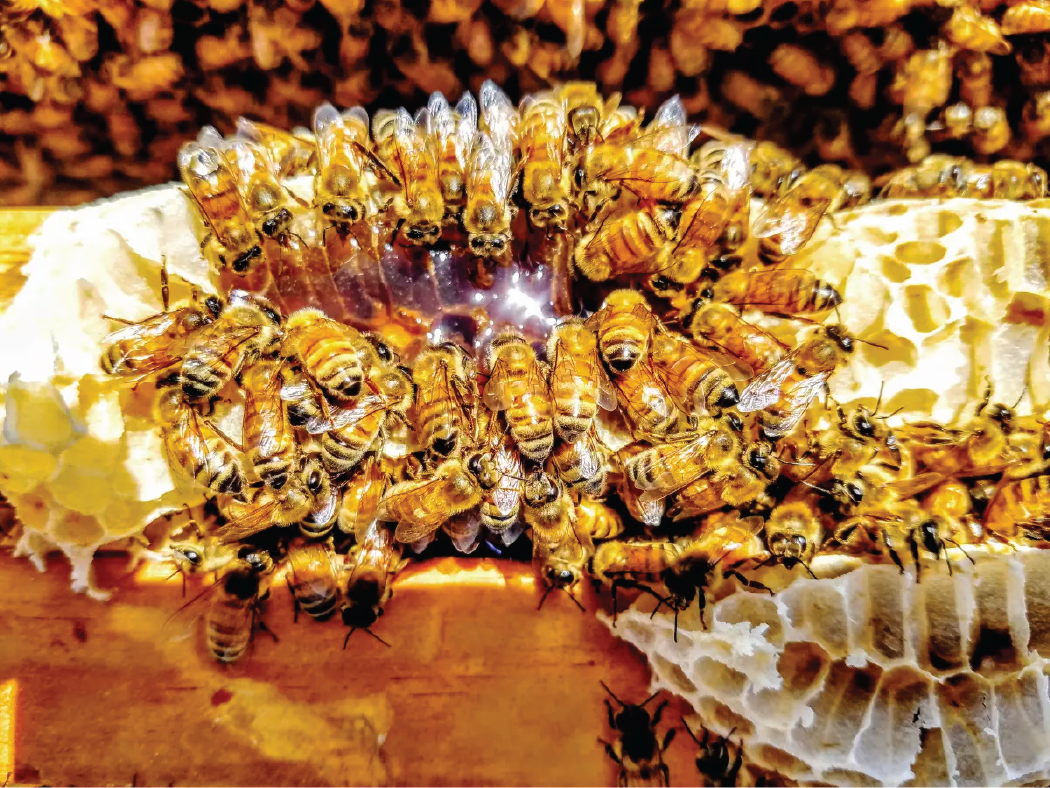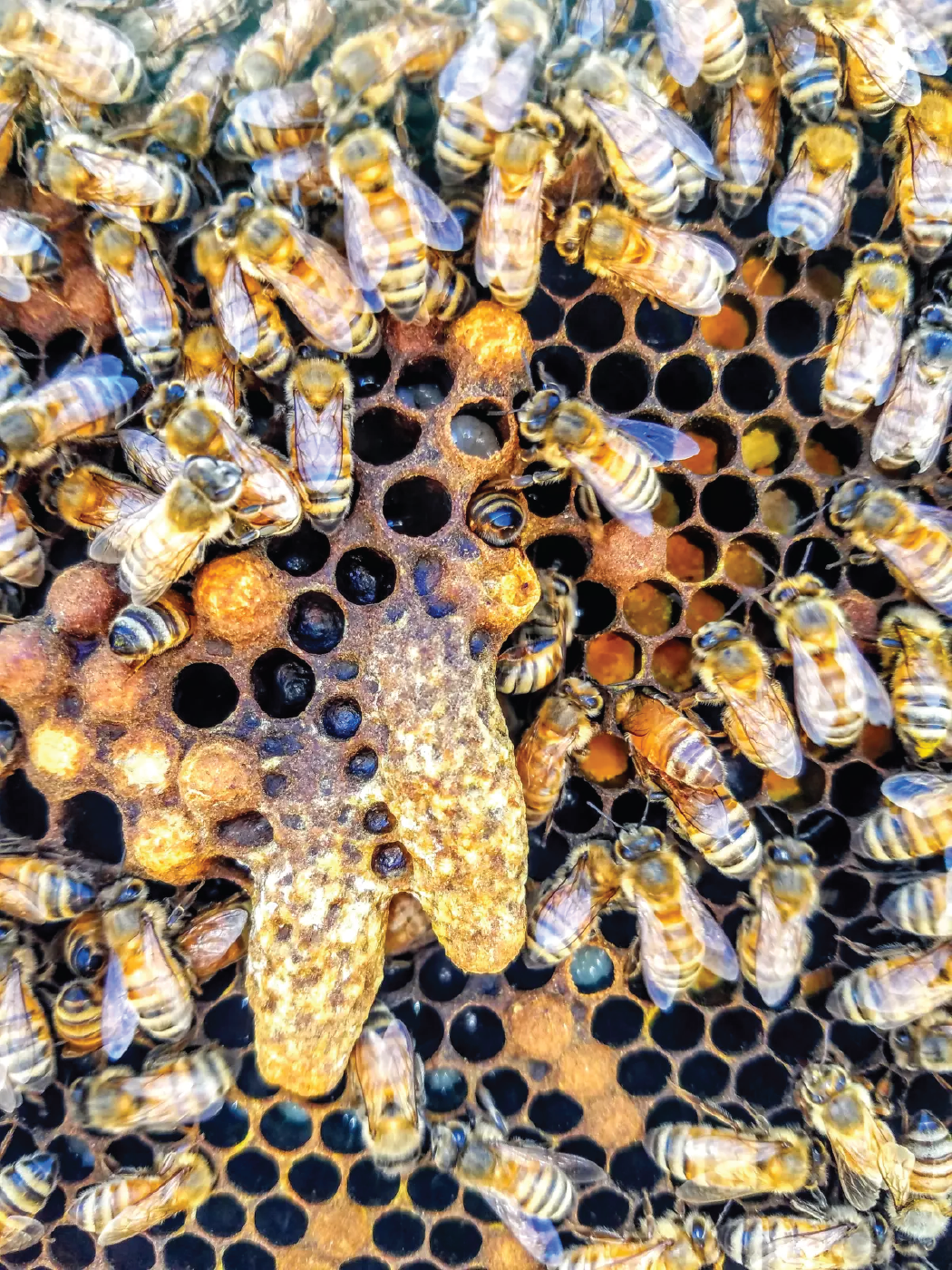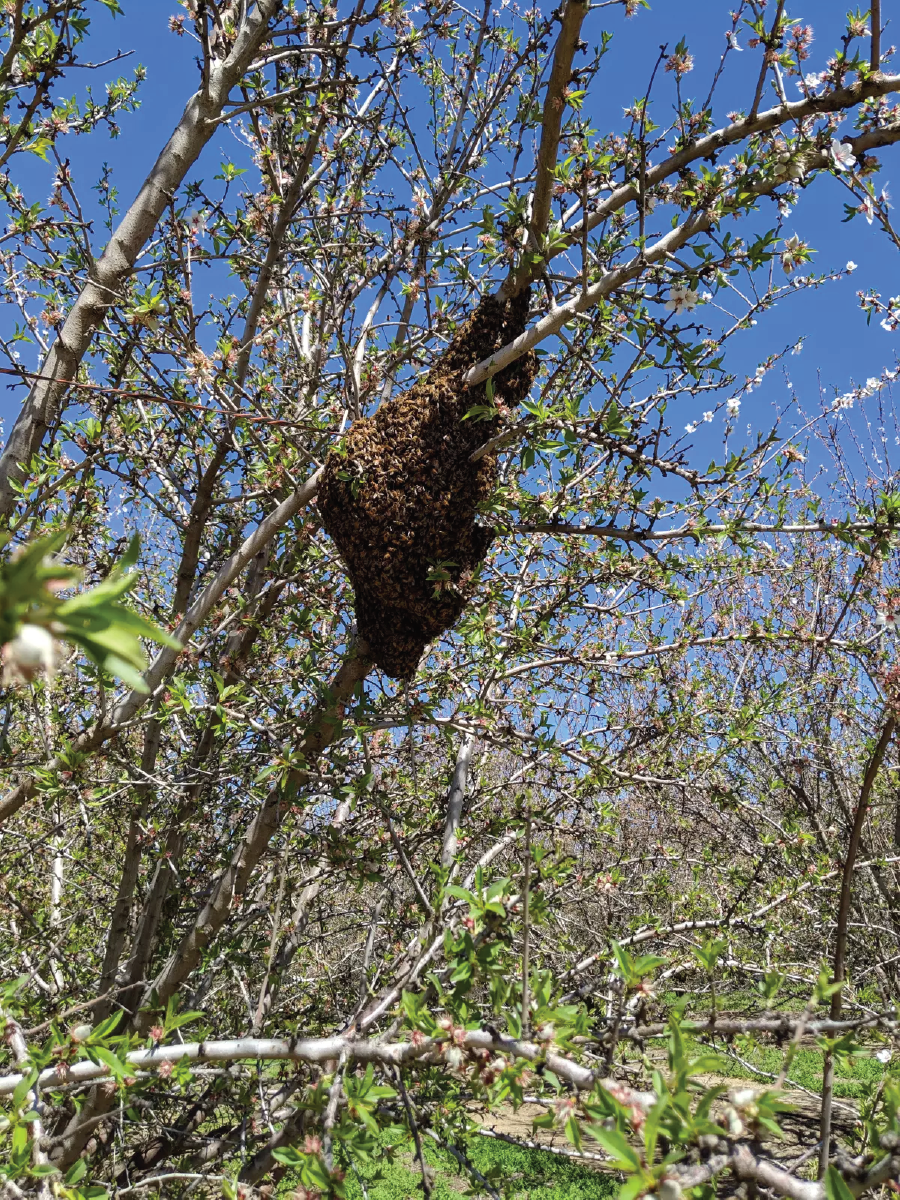California’s honeybee swarming season is moving in

Honeybees eating honey from a broken wax cell structure. (Leah Taylor)
As colonies of crucial pollinators scout out new nesting sites, residents have options for how to handle them in a beneficial way
By Leah Taylor
(This article was originally published in the April 13, 2024 edition of the San Diego Union-Tribune.)
As spring blooms across the Golden State, an annual spectacle unfolds in the orchards and fields of California: honeybee (Apis mellifera) swarming season. This natural phenomenon, both mesmerizing and vital to ecosystems and agriculture, marks the moment when honeybee colonies split and seek out new homes, creating a buzzing spectacle in the process.
Honeybee swarming is a remarkable display of nature’s resilience and organization. It typically occurs when a colony outgrows its hive and the queen bee, along with a large portion of worker bees, leaves in search of a new nesting site. Swarming bees form a dense cluster around the queen, often hanging from trees or structures, while scout bees venture out to find suitable locations for their new hive.
An ideal location for a honeybee colony to nest is a cavernous body, about 4- to 9-gallon capacity, with a small defensible entrance. Swarm prevention is a top priority for beekeepers who manage boxes of honeybees as a hobby or a profession, but our county contains unmanaged colonies that take advantage of a hole in the attic, our water meter box, downed tree trunk cavity, or other places deemed worthy.
California, known for its vast agricultural landscapes and diverse flora, plays a crucial role in honeybee swarming dynamics. Honeybees are vital pollinators, responsible for pollinating a wide variety of crops, including almonds, avocados and citrus fruits. With over a million acres of almond trees that require pollination, California’s Central Valley becomes a buzzing hub during swarming season as bees seek out the abundant pollen and nectar sources.

Nature’s royalty in the making: Twin queen cells on a bustling beehive frame. (Leah Taylor)
Despite their importance, honeybees face numerous challenges, including habitat loss, pesticide exposure and diseases. Swarming, while a natural process, can sometimes lead to conflicts with humans, especially when bees choose to settle in residential areas. To mitigate conflicts and support honeybee populations, beekeepers have swarm prevention as a top priority — and you can help.
Honeybee colonies are generally docile when swarming. They are scouting for a new place to live, rather than focused on defending their home, food resources and baby bees called brood. If you see a swarm approaching in the air, cover your face and neck, move calmly and quickly away, seeking shelter indoors if possible. If a swarm is forming a cluster on the sidewalk, a side of a structure or tree branch, they are generally resting and will move on in 24 to 48 hours, depending on the weather.
Who do you call if a swarm of honeybees has decided your property is a great place to make its new home? It is up to the property owner to have any swarms removed. This also applies to swarms found on city or county property.
Knowing the right person to call is half the battle when a swarm needs to be removed for public safety. The property owner should call a licensed pest control company, insured swarm removal service, or a beekeeper experienced in removing swarms. If any bee removal service operator uses pesticides, they are required by the state of California to be properly licensed and report any pesticide usage on the property. Companies or operators that remove swarms without using any pesticides are not required to obtain and maintain a pest control operator’s license.
It is important to do your research to find the best person for your situation. Visit this resource provided by the California Master Beekeeper Program for questions to ask before you hire someone, as well as best management practices for swarm removal, and FAQs about swarm removal: cambp.ucdavis.edu/live-honey-bee-removal-specialists.

Nature’s spectacle: A mesmerizing bee swarm takes residence in a tree. (Leah Taylor)
After the swarm is removed, it is critical to remove any wax or honey left behind, and seal any holes or entrances to discourage other swarms from moving in. Honeybees have an extremely acute sense of smell and will be attracted to the site of a previous swarm, long after the removed bees are gone. Any holes into buildings larger than a pencil must be sealed. For larger potential entrances, cover the area with a metal screen with six or more meshes per inch. Cavities that cannot be sealed off can be filled with expandable foam to make the area smaller and less favorable as a nesting site.
I know what you’re thinking … don’t we need to save the bees? Aren’t they out there doing good for pollination, flowers and the environment? Well, yes. Native bees and honeybees coexist in every corner of our county, happily pollinating our flowers, trees, landscapes, parks and orchards.
However, eliminating or removing swarms of honeybees will not negatively impact the population of honeybees in our area. Honeybees are an important part of the environment, but it is illegal to knowingly keep honeybees in any fashion other than in a managed bee box with moveable frames. Overall, public safety is the top priority when unmanaged swarms move in. If you want to “bee-friendly,” use native plants and ornamental plants that offer forage year-round in your gardens and landscapes.
As California gears up for another swarming season, it’s a reminder of the intricate relationship between humans and the natural world. By understanding the biology of the honeybees in our ecosystems, we can work toward coexistence and sustainable practices that benefit both agriculture and biodiversity.
Taylor is the University of California Cooperative Extension Master Gardener program coordinator and a master beekeeper.

